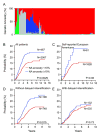Genomics of racial and ethnic disparities in childhood acute lymphoblastic leukemia
- PMID: 24382716
- PMCID: PMC4015138
- DOI: 10.1002/cncr.28531
Genomics of racial and ethnic disparities in childhood acute lymphoblastic leukemia
Abstract
Although the cure rates of childhood acute lymphoblastic leukemia (ALL) have improved dramatically in the past 40 years, not all children have benefited equally from this impressive progress. Racial and ethnic disparities in the incidence and treatment outcome of childhood ALL persist, with Hispanic children having an elevated risk of developing ALL and one of the lowest survival rates after ALL therapy. A critical barrier to progress is the lack of an understanding of the causes of ALL disparities, particularly racial and ethnic differences in ALL biology. In this review, the authors summarize the current knowledge on population variation in childhood ALL incidence and treatment outcome, discuss the contributing genetic and nongenetic variables, and highlight possible therapeutic interventions to mitigate disparities in ALL.
Keywords: childhood; disparity; ethnicity; genomics; leukemia; race.
© 2013 American Cancer Society.
Conflict of interest statement
Figures


References
-
- Linabery AM, Ross JA. Trends in childhood cancer incidence in the U.S. (1992-2004) Cancer. 2008;112(2):416–32. - PubMed
Publication types
MeSH terms
Grants and funding
LinkOut - more resources
Full Text Sources
Other Literature Sources
Miscellaneous

